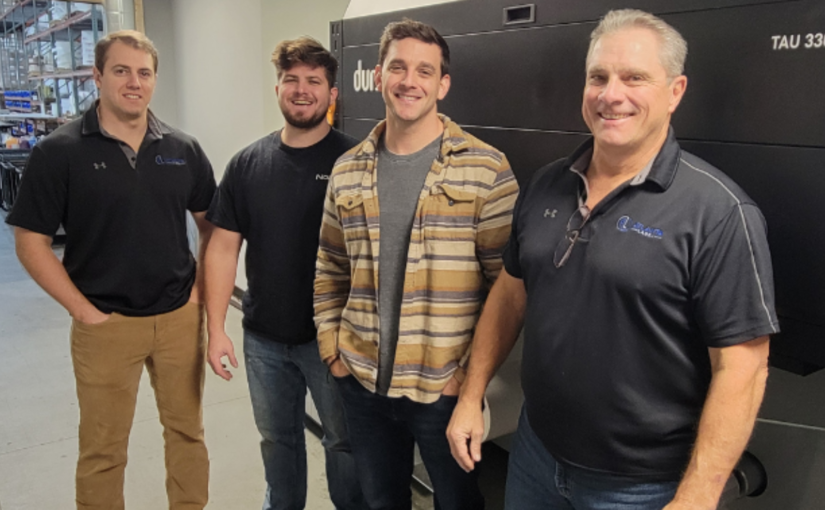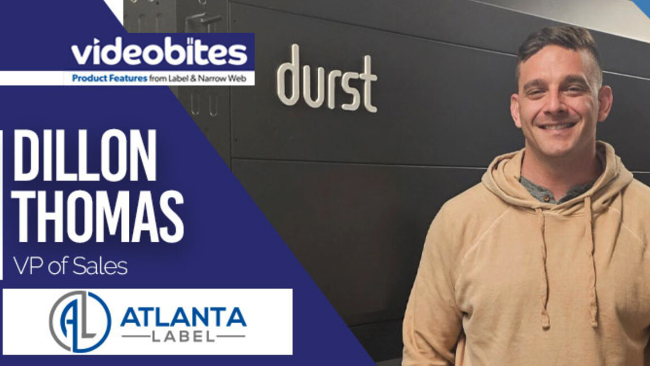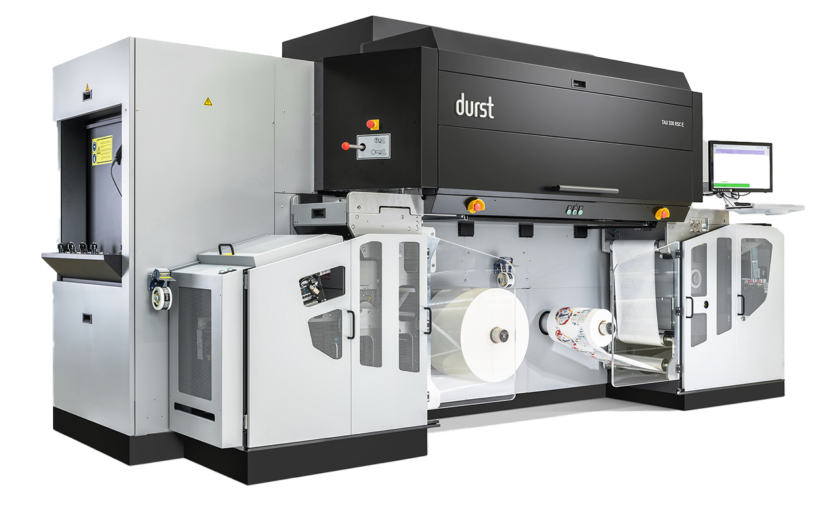Check out the article above!
It was an honor talking about our new equipment, running a label company, and team strategy with the Label and Narrow Web Team.

Check out the article above!
It was an honor talking about our new equipment, running a label company, and team strategy with the Label and Narrow Web Team.

After some time working at Atlanta Label, I finally ran into the term “Label Converter” as a definition for what we do. I had always referred to us as a “Label Printer”, “Pressure Sensitive Label Shop”, or “Print Shop” when I explained what we did to others, so I decided to do a deep dive into the origin of the term. We are referred to as a Label Converter in Georgia – but what does that really mean?
Conversion – The process of changing or causing something to change from one form to another.
We take rolls of material and transform them into labels, so this makes sense. These labels have to be printed onto paper & cut into the desired shape. However, the term is mainly referring to the machinery that is used & a specific part of the process.
Conversion machines exist in many industries & are simply just machines that alter the form of a product that runs through them. In the print world, conversion machines could also refer to the machines that cut material rolls (That we order to print on) into a desired size. They also refer to the Flexographic presses we use in particular.
With our Flexographic jobs, the converting process is preformed on the Flexo press itself. Not only will the press print the design, but it will also cut the labels to their desired shape, add laminate, and add any other finishing modifications if needed (Foil, UV, Etc). Any printing of colors is not really considered conversion, but cutting, laminating, adding other objects to the final sheet would be considered conversion in our world. The same is not true for digital printing presses, which work in tandem with a finishing unit.
So, there you have it. We are a Label Converter because the final steps in label conversion happen here. You can still call us a print shop if you want, but a Label Converter would be the more correct (And fancy) term.
Here is a detailed article on Web Converting that I found helpful:
Click Here
Greg: Hello, and welcome to our newest video bite. Where we bring you the latest news and products for our industry. I’m Greg Hrinya, editor of Label & Narrow Web and it’s a pleasure to sit down with Dillon Thomas – VP of Sales at Atlanta Label.
Label converters have been tasked with optimizing their efficiencies and Digital Printing has emerged as a key component of that success. To learn more about Atlanta Label and how digital printing has optimized their business, I’d like to welcome in Dillon Thomas. Dillon, thank you so much for joining us today.
Dillon: Of course, thanks for having me Greg.
Greg: So Dillon, to start out, what can you tell us about Atlanta Label?
Dillon: Atlanta Label is a family owned and operated company. We have been operating for over 40 years in the Metro Atlanta area. We have both Digital and Flexographic print capabilities. I’d say that above all else we pride ourselves on quality and customer service. We just want our customers to leave every interaction knowing that we have their back, and it’s important for us customers to feel that – not matter the situation – we are going to do whatever we can to help support their brand.
I’d say internally, we have put a lot of time and effort into rebuilding our company culture, improving our production processes, as well as implementing new equipment. In the past few years, we have experienced a lot of growth & we are really excited for the future.
Greg: That’s really good to know. Speaking of equipment, what is it like to have digital and Flexo in your shop?
Dillon: It’s good for our customers! With the flexographic capabilities for the medium to long run jobs and digital for the short run, and honestly it is just a value add for our customers.
Greg: That’s great. And what prompted your initial investment in digital printing & what was the learning curve like?
Dillon: So, a couple years ago we had the opportunity to get into the nutraceutical space, so we forged a relationship with a printer down the road and started outsourcing. Well… it was good and we built that initial book of business, but as the book of business grew…. Lead times extended out, quality wasn’t as good, so we knew we had to pull the trigger on bringing digital in-house.
So, we ended up choosing to go with Durst in-house and the learning curve wasn’t bad – it was just the initial installation of a new piece of equipment. The first month was a little rocky, but we never missed lead times and quality exponentially increased. It really wasn’t bad! Through the installation, our team had a good grasp on the equipment and what to do.
And then working with Durst – I mean – We could call them, they would be on the phone with us, or they would remote into our system, and if we had any other issues they would be in-house within a day or two. So, it was smooth to say the least.
Greg: There are a lot of digital print manufacturers out there, what was the driving force behind going with Durst?
Dillon: Durst was just excellent from the beginning. From the initial interactions, to taking us to see a Durst in action at other facilities, to negotiations on pricing; It was just a pleasure to work with Durst. Ultimately, they just treated us like we would treat our customers, which is hard to find. So, I think Durst, after dealing with other suppliers, they are just second to none. It was just an amazing experience from the beginning.
Greg: And what can we expect from Atlanta Label in the future?
Dillon: Yeah, we just expect to work on our sales and continue to grow. Hopefully we will be buying and implementing another Durst here soon.
Greg: That’s great. Thanks for sharing your experiences with us Dillon.

Should I Choose Digital or Flexographic Printing for My Label Project?
So, you have worked hard to figure out what the branding should look like on your products, or perhaps you have just figured out the specs on something to meet internal needs. Either way – the fact remains that you know what you want your label to look like.
Now that you have the design phase out of the way and you have selected a label manufacturer, you need to figure out if you want to use a digital or flexographic printing press. We can use the checklist below as a guide to select the proper machinery.
Do I have complex or super realistic art in my design? __
(Digital printing presses have a higher quality of print and color matching than Flexo presses)
Do I have metallic or raised textures on my design? __
(Our digital press comes with a finishing unit that can take care of complex finishing options)
Does quality matter more than anything? __
(Margin for error is lower on a digital press)
Am I printing lower volume – 1000 to 50,000 labels. __
(Lower run jobs are more cost effective with smaller set up and clean up times than Flexo)
Is my print super small on the label? __
(Digital presses can handle extremely small “fine” print)
Transparent material __
(The digital press plays nicer with specialty materials)
If you answered yes to one or more of these questions, then we would most likely go with a Digital Press for your job. We really want to use the digital press for small run jobs – or projects that have heavy detail and complexity.
Now- if your project is
Very few colors or blank labels. __
(Flexographic presses shine when they do not have to match digital quality)
Incredibly high volume – 100,000 to over a million labels. __
(Though the set up takes longer, Flexo presses are more cost effective in the long run. This is because of Speed and low ink costs.)
Security tags (High volume – not customer facing) __
Food Delivery labels __
Something you need a lot of – but cheap __
(Flexo presses specialize in speed and efficiency.)
If any of these sound like what you need, then Flexographic printing presses would be much more suitable to your project. We know the phrase “Lower quality” might scare you, but it is negligent in some cases. Using a digital press to print blanks is like using a flamethrower to start a campfire…. It’s just overkill & way too expensive.
So, here is a high-level summary of each.
Digital = High quality, cheaper for small run, powerful, more options
Flexographic = Speed, efficiency, cheaper for long run, higher margin for variance
We hope this helps shine some light on the press selection process, and we usually quote your job on both types of equipment (unless it is not possible on one of them). Our customer service specialists will always get you the right press for your product.
READY TO KICK OFF YOUR NEXT PROJECT?REQUEST YOUR FREE QUOTE!
GET MY FREE QUOTE